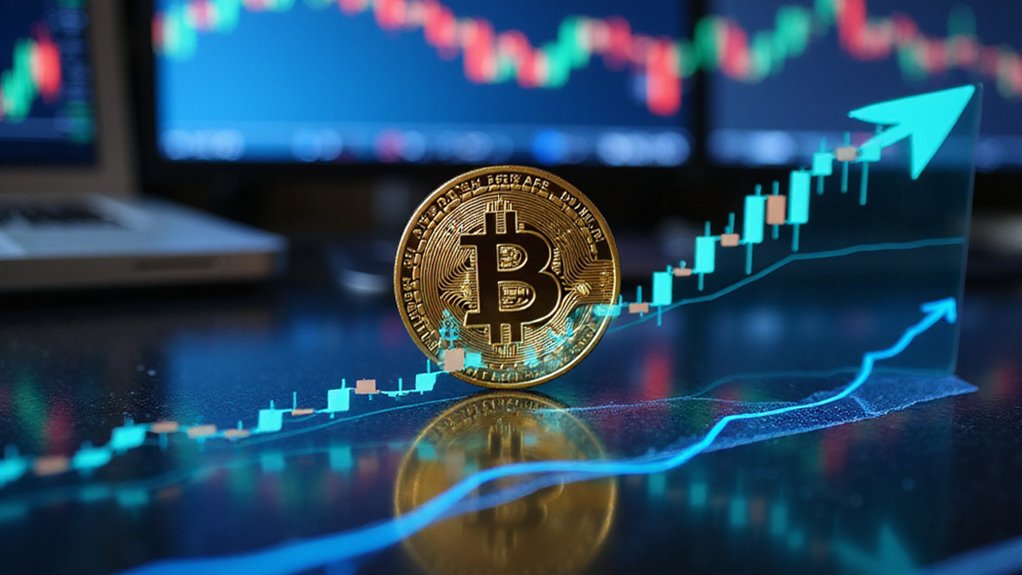Bitcoin’s market cap—$1.91 trillion as of May 2025—represents its total circulating value, calculated by multiplying supply (19.8+ million coins) by current price. This metric matters as both a stability indicator and cryptocurrency dominance barometer, consistently commanding over 50% of the entire crypto ecosystem. From humble $1 billion beginnings in 2013 to trillion-dollar status today, this figure quantifies the market’s collective verdict on Bitcoin’s proposition as a decentralized monetary system. The implications extend far beyond numerical fascination.

The meteoric rise of Bitcoin’s market capitalization—that ultimate barometer of cryptocurrency gravitas—represents one of the most remarkable financial phenomena of our era.
From its humble beginnings hovering around $1 billion in 2013, Bitcoin’s market cap has undergone a transformation of Ovidian proportions, reaching approximately $1.9 trillion by April 2025.
This figure, calculated simply by multiplying the circulating supply (currently over 19.8 million coins) by the prevailing price, offers investors a crystalline lens through which to view Bitcoin’s financial heft.
Market cap illuminates Bitcoin’s financial magnitude through the elegant mathematics of supply multiplied by price
This numerical behemoth doesn’t merely exist in a vacuum.
Bitcoin’s market dominance—often exceeding 50% of the entire cryptocurrency ecosystem—serves as both a litmus test for the asset’s relative strength and a weather vane indicating which way the crypto winds are blowing.
When altcoins surge or retreat, Bitcoin’s dominance fluctuates accordingly, creating a constantly shifting tableau of market dynamics that savvy investors monitor with hawk-like vigilance.
The year-on-year percentage change in Bitcoin’s market capitalization provides crucial insight into growth patterns for potential investors.
Why should one care about such metrics?
For starters, market capitalization functions as a reasonable proxy for stability—larger caps generally (though not invariably) correlate with reduced volatility, a comforting thought for the risk-averse investor.
Additionally, this figure represents the market’s collective verdict on Bitcoin’s value proposition, factoring in both present utility and future potential.
The scarcity principle underpinning Bitcoin—with its hard cap of 21 million coins—means that future market cap growth must derive primarily from price appreciation rather than supply expansion.
As of May 1, 2025, Bitcoin’s market capitalization reached an impressive $1.91 trillion, demonstrating continued investor confidence despite periodic price fluctuations.
This mathematical certainty creates an intriguing investment thesis that has attracted institutional players previously content to watch from the sidelines.
Projections suggesting a $3 trillion market cap by 2025 might seem ambitious, but in a domain where conventional financial wisdom often proves quaintly inadequate, such forecasts warrant serious consideration.
Bitcoin’s market capitalization ultimately matters because it quantifies the market’s evolving answer to a profound question: what value should we assign to a decentralized, algorithmically-constrained monetary system operating beyond traditional financial frameworks?
While Bitcoin maintains its position as the dominant cryptocurrency, competitors like Ethereum and Binance Coin continue to gain significant market share in the evolving digital asset landscape.
Frequently Asked Questions
How Is Bitcoin’s Market Cap Calculated?
Bitcoin’s market cap is calculated by multiplying its current price by the circulating supply of coins.
This seemingly simple formula (Price × Circulating supply) yields Bitcoin’s total network valuation—currently hovering around $950B when BTC trades at $50,000 with approximately 19 million coins in circulation.
Unlike traditional equities, this calculation excludes locked or unminted tokens, meaning the theoretical 21 million maximum supply remains irrelevant until those coins enter circulation.
Can Bitcoin’s Market Cap Decrease?
Bitcoin’s market cap can indeed decrease—a reality that sometimes eludes crypto enthusiasts caught in perpetual bullish fantasies.
Price drops directly diminish market capitalization, while regulatory headwinds, emerging cryptocurrency competitors, adverse economic conditions, and security breaches can all precipitate significant contraction.
The $1.9 trillion valuation (as of May 2025) isn’t immutable; market sentiment shifts with remarkable velocity in this space, where yesterday’s “store of value” narrative can rapidly transform into today’s liquidation cascade.
How Does Bitcoin’s Market Cap Compare to Gold?
Bitcoin’s market cap remains dwarfed by gold’s established $12-14 trillion valuation—an evidence to millennia of institutional trust versus a mere 15 years of digital existence.
While Bitcoin’s trajectory from zero to nearly $2 trillion reflects remarkable velocity, gold’s position as the premier reserve asset persists through superior liquidity ($130-200B daily trading volume) and proven inflation-hedging capabilities.
Bitcoin’s wild volatility further distinguishes it from gold’s relative stability, explaining institutional reluctance to grant it equal portfolio weighting.
Does Market Cap Affect Individual Bitcoin Value?
Market cap doesn’t directly set individual Bitcoin prices, but the relationship is unmistakably symbiotic.
Rising market cap reflects increased investor confidence and demand, which naturally elevates individual coin values.
Conversely, price movements drive market cap calculations.
This circular dynamic creates a feedback loop where market sentiment—manifested through cap fluctuations—indirectly influences trading psychology.
The limited supply of Bitcoin (capped at 21 million) further amplifies this effect, as scarcity becomes increasingly pronounced against growing institutional interest.
What Factors Most Influence Bitcoin’s Market Capitalization?
Bitcoin’s market capitalization is primarily influenced by supply-demand dynamics, investor sentiment, and macroeconomic factors.
Institutional adoption—the financial establishment’s reluctant embrace of crypto—significantly moves the needle, while regulatory developments can send valuations soaring or plummeting overnight.
Technological advancements and network security bolster confidence, while inflation concerns drive investors seeking hedges.
Perhaps most tellingly, market speculation (that quintessential human tendency toward financial herding) amplifies price movements, creating those stomach-churning volatility cycles Bitcoin has become notorious for.









